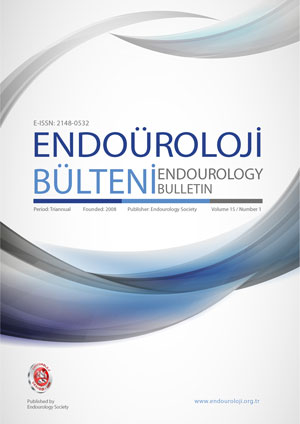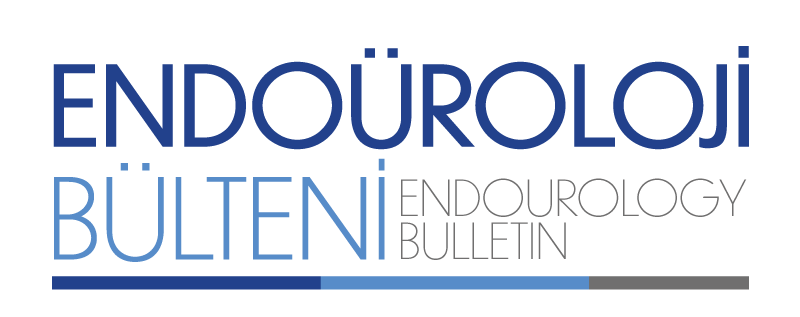
Editorial Board Message
Prof.Dr. R. Gökhan ATIŞ
Editorial Borad
Arbitrators List
Contents
Original Article
Supine percutaneous nephrolithotomy in impacted proximal ureteral stones
larger than 15 millimeters; Comparison of flexible ureterorenoscopy and
retroperitoneal laparoscopic ureterolithotomy
Taner Kargı, Mithat Ekşi, Ali Ayten, Yunus Çolakoğlu, Serdar Karadağ, İsmail Evren, Ahmet Hacıislamoğlu, Hakan Polat, Feyzi Arda Atar, Alper Bitkin, Selçuk Şahin, Ali İhsan Taşçı
Abstract
Objective: We aimed to compare the efficacy and safety of supine mini-percutaneous nephrolithotomy
(SMPCNL), retroperitoneal laparoscopic ureterolithotomy (RPUL), and flexible ureterorenoscopy (FURS) in the treatment of impacted proximal ureteral stones larger than 15 mm in diameter.
Material and Methods: Data of the patients who underwent SMPCNL, RPUL, and FURS in our institution for proximal ureteral stones between August 2015 and September 2020 were reviewed. Collected data included age, gender, body mass index (BMI) and hydronephrosis grade, stone density, duration of surgery, hospital stay and recovery period, stone-free and demographic data such as complication rates and duration of surgery.
Results: Overall, 162 patients were included. Of these patients, 52 (32.1%) were in Group 1 (SMPCNL
group), 53 (32.7%) were in Group 2 (RPUL group), and 57 (35.2%) ) were in Group 3 (FURS group). Mean operative times were 53±8.2 minutes in Group 1, 63.2±6.6 minutes in Group 2, and 73.7±7.5 minutes in Group 3 (p=0.000). The mean hospital stay was significantly shorter in Group 3 compared to the other groups (p=0.000). The stone-free rates at the initial evaluation were 100%, 90.3%, and 87.7% in the RPUL, SMPCNL, and FURS groups. This rate was significantly lower in the FURS group compared to the other groups (p=0.02).
Conclusion: SMPCNL and RPUL procedures are as safe as FURS in treating patients with proximal ureteral stones larger than 15 mm.
Keywords: supine, percutaneous nephrolithotomy, large impacted proximal ureteral stones
Original Article
Comparison of retrograde intrarenal surgery and percutaneous nephrolithotomy results for 20-30 mm kidney stones: A matched-pair analysis
Samet Şenel, Muhammed Emin Polat, Kazım Ceviz, Emre Uzun, Yusuf Kasap, Cüneyt Özden, Antonios Koudonas, Hüseyin Cihan Demirel
Abstract
Objective: To compare the results of retrograde intrarenal surgery and percutaneous nephrolithotomy for 20-30 mm kidney stones.
Material and Methods: The demographic, radiologic, clinic and surgery related data of 324 patients who underwent retrograde intrarenal surgery and percutaneous nephrolithotomy for 20-30 mm kidney stones between January 2013 and July 2022 were retrospectively analyzed. All patients were divided into two groups as retrograde intrarenal surgery group and percutaneous nephrolithotomy group according to the surgery performed. After matching two groups in terms of age, number of stones, location of stones, stone size and stone density, 122 patients were included in the study (61 patients in retrograde intrarenal group and 61 patients in percutaneous nephrolithotomy group as 1:1).
Results: The success rate of retrograde intrarenal surgery group (78.7%) and percutaneous nephrolithotomy group (80.2%) were similar (p=0.823). There was no difference between two groups in terms of infective and non-infective complications (respectively, p=0.752 and p=0.61). There were statistically significant difference between the two groups in duration of operation and hospitalization. The median operation time was 70 (30-100) minutes and the median hospital stay was 1 (1-28) days in the RIRS group, while the median operation time was 90 (50-160) minutes and the median hospital stay was 4 (2-10) days in the PNL group (p<0.001).
Conclusion: Retrograde intrarenal surgery is a good alternative in the surgical treatment of 20-30 mm kidney stones with similar success and complication rates and also shorter operation time and hospitalization time.
Keywords: percutaneous nephrolithotomy, retrograde intrarenal surgery, stone, urolithiasis
Original Article
Comparison of preoperative nomograms predicting lymph node invasion in patients underwent radical prostatectomy
Osman Can, Cemal Topal, Eyyüp Danış, Muammer Bozkurt, Emin Taha Keskin, Lutfi Canat, Abdulmuttalip Şimşek
Abstract
Objective: In some cases, pelvic lymph node dissection (PLND) is added to radical prostatectomy in the surgical treatment of prostate cancer. Some nomograms have been developed to predict which patient should undergo PLND. In our study, we aimed to evaluate the effectiveness of MSKCC, Briganti and Partin nomograms.
Material and Methods: Retrospectively, prostate cancer patients who underwent radical prostatectomy and PLND between September 2020 and October 2022 were included in the study. A total of 94 patients were included in the study. The rates of lymph node invasion were calculated according to the Briganti, MSKCC, and Partin nomograms using the demographic data of the patients and data such as prostate-specific antigen (PSA), clinical stage, gleason score, and biopsy characteristics.
Results: Ninety four patients who had radical prostatectomy were included in the study. While lymph node invasion was reported in 15 of the patients, it was not detected in 79 patients. The area under the curve (AUC)’s of the patients’ Briganti, Partin, and MSKCC nomograms were 0.922, 0.825, and 0.929, respectively. The accuracy rate of all 3 nomograms was statistically significant.
Conclusion: The sensitivity of MSKCC and Briganti nomograms in predicting lymph node invasion was found to be slightly higher than Partin nomogram. However, Briganti, Partin, and MSKCC nomograms can be used safely to predict lymph node invasion in prostate cancer patients.
Keywords: Partin, MSKCC, Briganti, prostate cancer
Original Article
The Rezum procedure in benign prostate hyperplasia: Initial experience at a single center in Turkey
Mert Kılıç, Mevlana Derya Balbay
Abstract
Objective: In this study, we aimed to present our initial experiences with the Rezum procedure, including voiding and sexual outcomes.
Material and Methods: A total of 24 patients who underwent the Rezum procedure between June 2021 and August 2022 were included in this retrospective study. For each procedure, 2 to 12 injections were applied to the median and lateral prostate lobes. We analyzed the baseline and follow-up data and compared the outcomes of patients with and without the median lobe of the prostate.
Results: The mean follow-up time was 7.5 months. The International Prostate Symptom Score decreased in all patients by 15 points on average (p<0.001), while the maximum urinary flow increased by 5 mL/s on average in all patients except three who had similar values (p<0.001). The post-void residual decrease was 55 mL (p<0.001). In terms of the variables examined, there was no significant difference between patients who had a median lobe and those who had not. Neither any sexual worsening nor any major complications were observed. As for minor complications, two patients had macrohematuria, four had dysuria that required non-steroidal anti-inflammatory drug therapy, and two required re-catheterization due to urinary retention.
Conclusion: The Rezum procedure is an effective and practical method, even in patients who have median lobes of the prostate, and preserves sexual functions.
Keywords: lower urinary tract symptoms, minimally invasive surgery, prostatic hyperplasia, Rezum
Original Article
The effect of intravesical stent length and Propiverine on ureteral stent related symptoms – Prospective controlled trial
Osman Can, Mustafa Erkoç, Eyyüp Danış, Muammer Bozkurt, Alper Ötünçtemur, Halil Lütfi Canat
Abstract
Objective: Ureteral double J stents are widely utilized in urolithiasis. Disturbing stent-related symptoms may occur while the stent is in location. Various medical agents and stent-related solutions were examined for this problem. However, a definite drug has still not been found. We aimed to research the effect of propiverine on stent-related symptoms.
Material and Methods: Patients who underwent ureteroscopic stone surgery between June 2020 and May 2022 were included in the study. While the control group was untreated, the treatment group received 45 mg of propiverine daily after 1 week of the operation. Stent-related symptoms were assessed by ureteral stent symptom questionnaire (USSQ) at the end of 1st week and 3rd week of surgery. In addition, the intravesical stent parts of all patients were quantitatively measured with a ruler during stent removal at the end of 3 weeks.
Results: A total of 177 patients were assessed in the study. Eighty-seven patients were control and 90 patients of them were treatment group. According to USSQ, urinary symptoms scores, body pain scores, general health scores, work performance scores, sexual health scores, additional problem scores, and global quality of life (QoL) scores were found to decrease in the treatment group (p<0.001 All domains). Intravesical stent length was found positive correlation with the urinary symptom score (1st week) of all patients.
Conclusion: Stent-related symptoms are more likely in patients with longer intravesical stent length. Propiverine successfully relieves stent-related symptoms.
Keywords: Propiverine; Stent related symptom; Double J stent; USSQ


